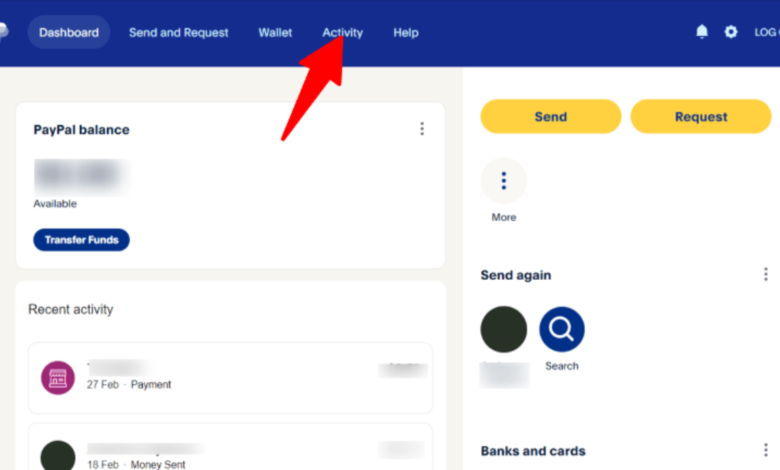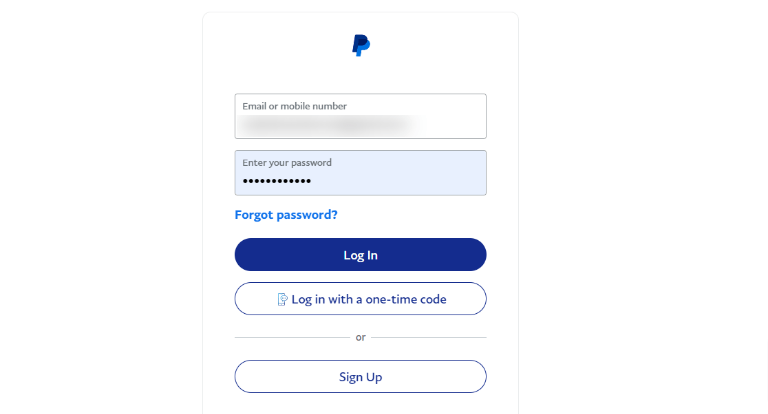Understanding PayPal Login Activity: A Comprehensive Guide

paypal login activity has become a staple in online transactions, offering a secure and convenient way to manage financial activities. However, understanding the nuances of PayPal login activity is crucial for both security and optimal use. This guide will dive deep into what PayPal login activity entails, how you can manage it, and the importance of monitoring it. We’ll break it down into several sections to ensure you get a complete picture.
What is PayPal Login Activity?
Overview of PayPal Login Activity

PayPal login activity refers to the records of every time you log into your PayPal account. This includes the date, time, and location of each login attempt. PayPal keeps a log of these activities to help you monitor and review access to your account. It’s an essential feature for maintaining security and ensuring that your account is only accessed by you.
When you log into PayPal, the system records various details such as your IP address, the device used, and the location. This information is valuable for detecting unauthorized access and verifying your identity. Understanding these logs can help you spot any suspicious activity quickly, giving you an edge in protecting your account from potential threats.
Why Monitoring Login Activity is Important
Monitoring your PayPal login activity is crucial for several reasons. First and foremost, it helps you ensure that no one else is accessing your account without your permission. By regularly checking your login history, you can spot any unusual or unauthorized activity early and take action to secure your account.
Another reason to monitor your login activity is to protect yourself from identity theft. If you notice any login attempts from unfamiliar locations or devices, it could indicate that someone is trying to steal your credentials. Keeping a close eye on these logs allows you to react swiftly to any potential threats.
How to Access Your Login Activity
Accessing your PayPal login activity is straightforward. Here’s a step-by-step guide on how to check it:
- Log In to Your PayPal Account: Start by logging into your PayPal account using your username and password.
- Navigate to Account Settings: Once logged in, go to the “Settings” section, usually represented by a gear icon.
- Find Security Settings: In the settings menu, locate the “Security” tab.
- View Login Activity: Under the security settings, you should find an option for “paypal login activity” or something similar. Click on this to view a detailed log of your recent logins.
By following these steps, you can easily access and review your login activity to ensure everything is in order.
How to Protect Your PayPal Account
Setting Up Strong Passwords
One of the first lines of defense for your paypal login activity account is a strong password. Ensure your password is unique and complex, combining letters, numbers, and special characters. Avoid using easily guessable information like birthdays or common words.
To further enhance your password’s strength, consider using a password manager. These tools can generate and store complex passwords securely, reducing the risk of unauthorized access. Regularly updating your password is also a good practice to minimize potential security risks.
Enabling Two-Factor Authentication
Two-factor authentication (2FA) adds an extra layer of security to your paypal login activity account. With 2FA, you need to provide an additional verification code sent to your phone or email, in addition to your password. This means that even if someone manages to obtain your password, they won’t be able to access your account without the verification code.
To enable 2FA on paypal login activity, go to the “Security” settings in your account. Look for the option to set up two-factor authentication and follow the prompts to complete the setup. This simple step significantly enhances your account’s security.
Regularly Reviewing Account Activity
Regularly reviewing your account activity, including login activity, is essential for maintaining security. Set aside time to check your login logs and transaction history frequently. Look out for any unusual patterns or activities, such as logins from unfamiliar locations or devices.
If you notice any discrepancies or suspicious activity, report it to PayPal immediately. The sooner you address potential issues, the better you can protect your account from potential damage.
Common Issues with PayPal Login Activity
Unusual Login Locations
One common issue with PayPal login activity is noticing logins from unusual or unexpected locations. This could be a sign that someone is trying to access your account from a different geographical area. It’s important to investigate these anomalies to ensure your account remains secure.
If you see login attempts from locations you don’t recognize, it could be worth changing your password and enabling two-factor authentication if you haven’t already. Additionally, consider contacting PayPal’s customer support for further assistance and guidance.
Multiple Failed Login Attempts
Another issue to watch for is multiple failed login attempts. This could indicate that someone is trying to guess your password or gain unauthorized access to your account. paypal login activity may temporarily lock your account after several failed login attempts to prevent unauthorized access.
If you experience multiple failed login attempts, it’s crucial to review your account’s security settings and update your password immediately. Ensure that your password is strong and not easily guessable to minimize the risk of a successful breach.
Account Lockout Issues
Occasionally, you might encounter account lockout issues due to repeated failed login attempts or other security measures. If your account gets locked, you’ll need to follow PayPal’s instructions to regain access. This typically involves verifying your identity through email or phone.
To avoid future lockout issues, make sure to use the correct login credentials and follow best practices for password management. If you encounter persistent problems with account access, reach out to PayPal’s support team for assistance.
How PayPal Protects Your Login Information
Encryption and Secure Connections
PayPal employs advanced encryption techniques to protect your login information. When you log into your PayPal account, your data is transmitted over a secure connection, ensuring that your credentials are protected from unauthorized access. Encryption scrambles your data into an unreadable format, making it difficult for anyone to intercept and decode it.
PayPal uses Secure Socket Layer (SSL) technology to establish a secure connection between your device and its servers. This ensures that your login information is transmitted securely and reduces the risk of data breaches or eavesdropping.
Monitoring and Fraud Detection
PayPal actively monitors account activity for signs of fraud or suspicious behavior. Their systems are designed to detect unusual patterns, such as multiple login attempts or transactions from unfamiliar locations. If any suspicious activity is detected, PayPal may take steps to protect your account, such as temporarily locking it or sending you alerts.
In addition to automated fraud detection, PayPal also employs teams of security experts who review and investigate potential threats. This multi-layered approach helps ensure that your account remains secure and that any fraudulent activity is addressed promptly.
User Education and Support
PayPal provides resources and support to help users understand and manage their account security. Their website offers tips and guidelines for maintaining a secure account, including best practices for password management and recognizing phishing attempts.
If you have questions or concerns about your login activity or account security, PayPal’s customer support team is available to assist you. They can guide how to address specific issues and help you navigate any security-related challenges.
Managing PayPal Login Activity for Business Accounts
Importance of Monitoring for Businesses
For businesses using PayPal, monitoring login activity is even more critical. Business accounts often handle larger transactions and have multiple users, making them attractive targets for cybercriminals. By keeping a close eye on login activity, you can ensure that only authorized personnel have access to your account and that no suspicious activity goes unnoticed.
Regularly reviewing login logs can also help you identify any potential security gaps or areas for improvement. For instance, if you notice frequent logins from unfamiliar locations, it may indicate a need for stronger security measures or additional training for your team.
Setting Up User Permissions
If your business account has multiple users, it’s important to set up appropriate permissions for each user. PayPal allows you to manage user access by assigning different roles and permissions. This ensures that each user only has access to the functions and information relevant to their role.
To set up user permissions, go to the “Account Settings” section of your PayPal business account and select “Manage Users.” From there, you can add or remove users and assign specific roles based on their responsibilities. This helps minimize the risk of unauthorized access and ensures that your account remains secure.
Regular Security Audits
Conducting regular security audits is a good practice for managing PayPal login activity in a business context. These audits involve reviewing your account’s security settings, login logs, and user permissions to identify any potential vulnerabilities or areas for improvement.
During an audit, consider evaluating the effectiveness of your current security measures and making any necessary updates. This could include changing passwords, adjusting user permissions, or implementing additional security features. Regular audits help ensure that your business account remains protected and that any potential issues are addressed promptly.
Troubleshooting PayPal Login Issues
Recovering Forgotten Passwords
If you’ve forgotten your PayPal password, you can easily recover it by following the password reset process. On the PayPal login page, click the “Forgot Password?” link and follow the prompts to reset your password. You’ll need to provide your email address or phone number associated with your account.
PayPal will send you a link or code to reset your password. Make sure to choose a new, strong password and avoid using easily guessable information. Once you’ve successfully reset your password, you should be able to log in to your account as usual.
Resolving Account Lockouts
If your account is locked, follow PayPal’s instructions to regain access. This typically involves verifying your identity through email or phone. PayPal may ask you to answer security questions or provide additional information to confirm your identity.
If you encounter difficulties during the account recovery process, contact PayPal’s customer support team for assistance. They can guide you through the steps to unlock your account.





